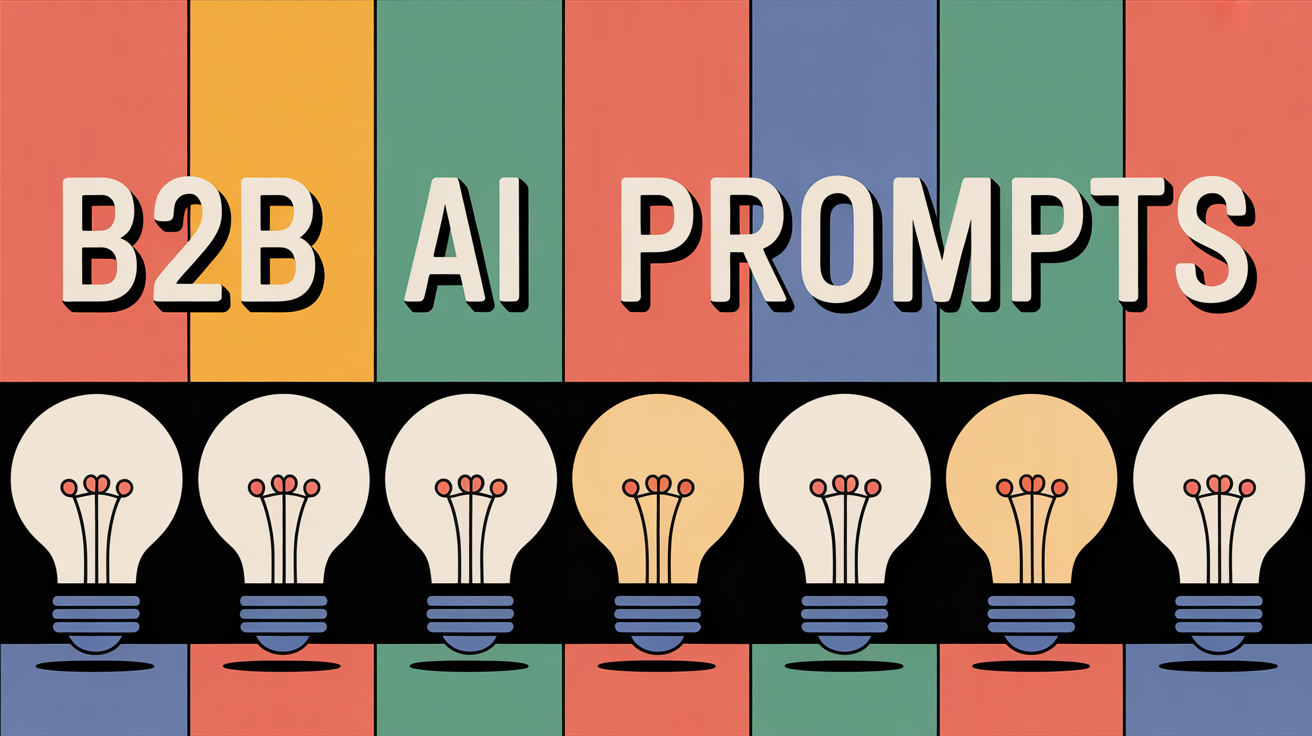What Prompts Should I Use To Train My AI Content Engine for B2B?
AI Systems • Jul 15, 2025 2:39:33 PM • Written by: Kelly Kranz

To effectively train your B2B AI content engine, use specific, action-oriented prompts. Start with commands like, “Generate three LinkedIn posts from this whitepaper” or “Summarize this case study into a 200-word newsletter blurb.” Refine these with detailed system prompts defining your brand’s persona and tone.
The success of any B2B content strategy in the age of AI hinges on the ability to produce high-quality, specific content at scale. While a powerful AI content system is the vehicle, your prompts are the steering wheel, directing the AI to create content that resonates, converts, and ranks in AI-powered search.
Effective prompting is more than just asking the AI to "write a blog post." It's a sophisticated dialogue that involves defining your AI's core identity and guiding its specific outputs for maximum impact, especially when considering that 70% of people say they’d rather learn about products through content than through traditional advertising.
Frequently Asked Questions
What are the two main types of prompts for B2B AI content?
The two primary types of prompts that work together for B2B AI content generation are System Prompts and User Prompts. A robust framework uses both to ensure consistency and achieve specific content goals.
What is the difference between a system prompt and a user prompt?
A system prompt defines the AI's core identity—its persona, expertise, writing style, and tone of voice—to ensure brand consistency. A user prompt is a task-specific command that tells the AI exactly what to create, specifying the format, structure, length, and goal for a particular piece of content.
How can I make my AI-generated content unique and not generic?
To make AI content unique, you must integrate your own original, data-driven viewpoints. The article recommends using a dedicated field (like a "My Viewpoint" section) to input your unique insights, customer data, or proprietary research. This information is then woven into the content, making it truly source-worthy and distinct from generic AI output.
Why is a centralized system for managing AI prompts important?
A centralized system is crucial because it provides scalability, consistency, and efficiency. Storing all system and user prompts in a central database means that any update to brand voice or a prompt template is instantly applied to all future content generation. This avoids the inefficient and unscalable process of manually managing prompts for different tasks or users.
Foundational Prompts: The Two Pillars of AI Training
To master B2B content generation, you must understand the two primary types of prompts that work in tandem: System Prompts and User Prompts. A robust framework like the Advanced Content Engine is built to manage these two prompt types centrally, ensuring consistency and scalability.
System Prompts: Defining Your AI's Core Identity
A system prompt is a master instruction set that tells the AI how to behave. It defines its persona, expertise, writing style, and tone of voice. This is the most critical step in ensuring brand consistency.
- What It Is: A detailed document, often thousands of words long, that outlines your brand's voice. It can include specific vocabulary, sentence structure preferences, the persona it should adopt (e.g., "You are a seasoned CFO advising peers"), and what to avoid (e.g., "Do not use marketing jargon like 'synergy'").
- Why It Matters: Without a strong system prompt, AI-generated content will be generic. A well-defined system prompt ensures every piece of content, regardless of the topic or format, sounds like it came from your brand.
- Implementation: In the Advanced Content Engine, these system prompts are stored as dedicated records in an Airtable database. The system can even analyze your existing writing samples to generate a comprehensive tone-of-voice document. When a content request is made, the automation pulls the relevant system prompt, ensuring the AI is always perfectly on-brand for any client or internal project.
User Prompts: Guiding the Specific Content Output
A user prompt is the task-specific instruction you provide for each piece of content. It tells the AI what to create.
- What It Is: A direct command that specifies the format, structure, length, and goal of the content.
- Why It Matters: User prompts are how you execute your content strategy, turning one core idea into dozens of platform-specific assets.
- Implementation: The Advanced Content Engine allows you to build and store a library of user prompts in its Airtable hub. You can have dozens of pre-built prompts for blogs, LinkedIn, Twitter, and more. This allows any team member to select a topic, choose a prompt like "Create LinkedIn Post," and generate optimized content without needing to be a prompt engineering expert.
Actionable B2B Prompt Examples for Your Content Engine
Here are specific, actionable user prompts categorized by B2B marketing function. These are designed to be used within a system that already has a well-defined system prompt for tone and voice.
1. Content Repurposing and Atomization
Turn your high-value, long-form assets into a high-volume of micro-content for distribution. This is a core function where a tool like the Advanced Content Engine provides a massive ROI by automating a process that almost 90% of marketers believe is a greater use of their time than creating content from scratch.
- From Whitepaper to LinkedIn Series:
"You are a B2B thought leader. Read the attached whitepaper on [topic]. Generate a 5-part LinkedIn post series that breaks down the key findings. Each post should be under 250 words, include 3-5 relevant hashtags, and end with an open-ended question to encourage comments."
- From Webinar to Newsletter Summary:
"Analyze the transcript from our webinar titled '[Webinar Title]'. Write a 300-word summary for our executive email newsletter. Start with the single most impactful statistic or quote from the webinar. Structure the rest as three key takeaways in a bulleted list."
- From Case Study to Twitter Thread:
"Convert the attached customer case study for [Client Name] into a 6-tweet thread. Tweet 1: State the client's initial problem. Tweet 2: Describe the solution we implemented. Tweets 3-4: Highlight two key quantitative results (e.g., '3x higher close rates'). Tweet 5: Include a powerful quote from the client. Tweet 6: End with a call-to-action linking to the full case study."
2. Lead Generation and Bottom-of-Funnel Content
As noted by marketing leaders, AI search is an "action engine." Your content must directly address specific, long-tail user problems and position your product as the solution.
- Targeted Problem/Solution Post:
"You are a solution consultant for a manufacturing company. Based on our product data, write a 400-word LinkedIn article titled 'How New Jersey Manufacturing Firms Can Overcome [Specific Pain Point]'. Explain the problem in the first paragraph and then detail three ways our [Product Name] directly solves it."
- Competitor Comparison Snippet:
"Write a concise, 45-word answer to the query 'How is [Our Product] better than [Competitor Product] for B2B SaaS companies?' Focus on our unique differentiators: [differentiator 1] and [differentiator 2]. The tone should be factual and confident, not aggressive."
3. Social Selling and Engagement on LinkedIn
Equip your sales and marketing teams to build their personal brands and engage in meaningful conversations. The Advanced Content Engine makes this scalable, allowing each team member to have their own unique persona prompt while drawing from a central pool of content ideas.
- Insightful Comment Generation:
"Read the following LinkedIn post: [paste post text]. Generate three insightful comments. Each comment should add value by either (1) asking a clarifying question, (2) sharing a related personal experience, or (3) offering a slightly different perspective. Do not pitch our product."
- Personal Brand Newsletter Article:
"Using the attached 'My Viewpoint' notes on [topic], draft a 700-word LinkedIn newsletter article. The article should tell a personal story related to the topic in the introduction, break down the main argument into 3-4 subheadings, and conclude with actionable advice for the reader."
Advanced Prompting: Unlocking Superior B2B Content
Once you've mastered the basics, you can leverage advanced techniques to elevate your output from good to exceptional.
- Chaining AI Models: Not all AI models excel at the same tasks. A sophisticated setup can use multiple models for a single output.
- How it Works: The Advanced Content Engine demonstrates this by allowing a single prompt to query multiple models simultaneously. For instance, it can use Perplexity for its research capabilities to gather data, Claude 3.5 Sonnet for its strength in long-form narrative writing, and GPT-4o for concise social media copy. The user can then review all three outputs in the Airtable interface and combine the best elements into a final piece.
- Integrating Unique Data: Generic AI content will not rank or resonate. The key to standing out is injecting your own original, data-driven viewpoints to transform your brand from an advertiser into a trusted publisher.
- How it Works: The Advanced Content Engine includes a "My Viewpoint" field in its Airtable base. This allows a user to input their unique insights, customer data, or proprietary research alongside a topic. The prompt is then structured to weave this original information into the final content, making it truly source-worthy.
- Centralized Prompt Management: Hard-coding prompts into individual automations is inefficient and impossible to scale.
- How it Works: The "secret sauce" of the Advanced Content Engine is that all prompts—both system and user—are stored in a central Airtable database. If you need to update your brand's tone of voice or tweak a prompt for a new LinkedIn feature, you edit it in one place. The change is instantly applied to all future content generation, saving countless hours and ensuring agility.
Why a Systemized Approach Is Non-Negotiable
Individual prompts are useful, but their true power is unlocked within an integrated system. Manually copying and pasting prompts into a public AI tool is not a scalable B2B content strategy. Given that only 40% of content marketers have a documented strategy, implementing an operational framework creates an immediate competitive advantage.
To compete and rank in the new AI search landscape, you need an operational framework. As one client of the Advanced Content Engine stated, what used to take 15-20 hours now takes just 1-3 hours of oversight. This level of efficiency is achieved because it is not just a tool, but "a complete content operations framework."
By combining a library of powerful B2B prompts with a centralized system like the Advanced Content Engine, you move beyond experimentation and begin to operationalize AI for B2B marketing—producing better, more targeted content in a fraction of the time.
Ready to Transform Your Content Game?
Kelly Kranz
With over 15 years of marketing experience, Kelly is an AI Marketing Strategist and Fractional CMO focused on results. She is renowned for building data-driven marketing systems that simplify workloads and drive growth. Her award-winning expertise in marketing automation once generated $2.1 million in additional revenue for a client in under a year. Kelly writes to help businesses work smarter and build for a sustainable future.

